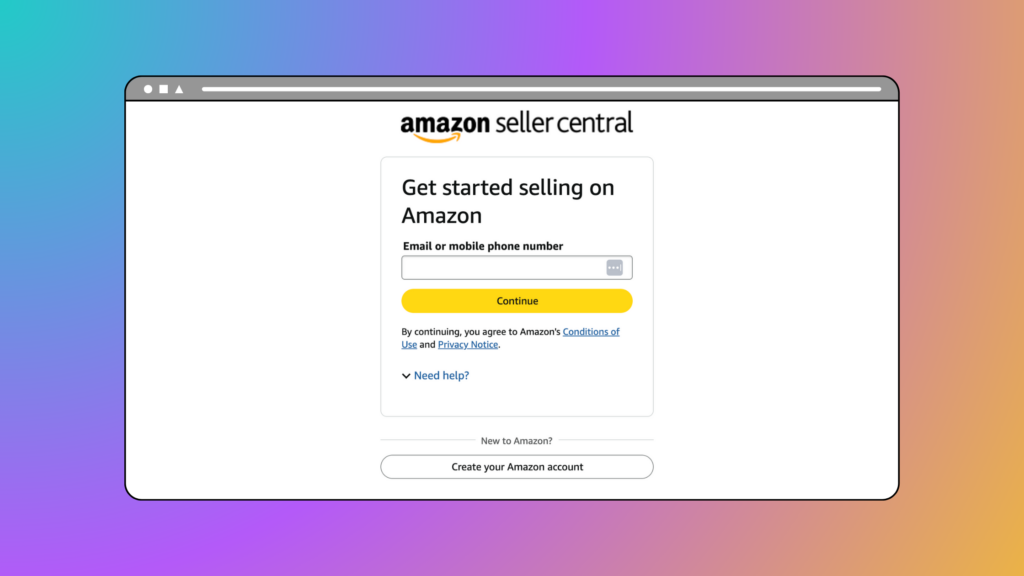- Blog
-
For Sellers
How to get approval for restricted categories on Amazon
Restricted doesn’t mean banned. Here’s how to get your listings through the door.

Finding the perfect product to sell on Amazon can feel like striking gold—until you discover it’s in a restricted category. That sinking feeling hits hard when you realize your brilliant product idea might be locked behind Amazon’s approval process.
But here’s the thing: restricted doesn’t mean impossible. It just means you need to jump through a few hoops first.
Amazon’s restrictions exist for good reasons, and getting approval is absolutely doable when you know the process. This guide walks you through everything you need to know about Amazon’s restricted categories, how to tell if your product needs approval, and exactly how to navigate the application process successfully.
Amazon categories and sub-categories with restrictions
Amazon places restrictions on the following product categories and sub-categories.
Alcohol
- Wine sold by pre-approved sellers
- Alcohol-related accessories
- Alcohol-related memorabilia without alcohol
- Distillation kits
- Non-alcoholic beverages with 0% alcohol by volume (ABV)
Tobacco and Tobacco-Related Products
- Ashtrays
- Cigarette paper
- Lighters
- Non-tobacco collectibles
- Nicotine gums or patches
Offensive and controversial materials
- Strictly no products allowed
Sex and sensuality
- Performance enhancers
- Men’s and women’s toys
- Birth control products
Drugs and drug paraphernalia
- Legal over-the-counter drugs and paraphernalia that follow applicable laws and regulations
Explosives, weapons, and related items
- Ammunition for pistols and rifles
- Slugs
- Shotgun shells
- Ballistic loads
- Black powder
- Gun powder
- Bullets
Gambling and lottery
- Non-functional slot machines intended for use as displays or toys
Hazardous and dangerous items
- Fire-fighting foam products
- Mercury-free batteries
- Rechargeable batteries
- US Environmental Protection Agency (EPA)-certified portable fuel containers
Human parts and burial artifacts
- Human bones intended for medical purposes
- Human bones permitted for sale in the area where they’re sold
- Wigs made from human hair
Lockpicking and theft devices
- Blank keys
Animal-related products
- Live shellfish and crustaceans
- Products resembling animal parts or products, but aren’t made from those animals.
- Shark teeth jewelry
- Veterinary products
Collectible coins
- Government-minted graded collectible coin, US Mint gold, silver, platinum, or palladium coins
Sports collectibles
- Trading cards
- Autographed items
Fine art
- Unique paintings and two-dimensional media
- Limited-edition prints or photographs
- Secondary-sale works
- Ex-libris prints
Music
- CDs, cassettes, vinyl, and other sound recordings
Historical and advertising collectibles
- Vintage collectibles related to historical people, places, or events, promotional materials associated with consumer brands
Surveillance equipment
- Video-only surveillance that doesn’t record audio
- Answering machines
- Video cameras
- Night-vision accessories
Industrial and scientific
- Lab equipment and supplies
- Industrial materials
- Power transmission
- Electronic components
- Sanitation and janitorial products
Medical devices and accessories
- Adhesive bandages
- Crutches
- Eyeglasses frames
- Otoscopes
- Personal Sound Amplification Products (PSAPs)
- Sharps containers
Medication
- Any over-the-counter drug approved by the Food and Drug Administration
Topicals
- FDA-approved new and unused topicals
Grocery and gourmet food
- Adequately labeled, non-perishable products
Accessories
- Automotive batteries
- New tires that follow regulations
- Parts that retain the full functionality of all emissions control equipment, including On-Board Diagnostic (OBD) systems, whether they’re used alone or with other parts
- EPA-certified portable fuel
- Vehicle accessories
Baby products
- Topicals
- Food
- Feeding products
- Diapers
- Strollers
- Carriers
- Toys
Beauty topicals
- Cosmetics
- Fragrance
- Skincare
- Makeup
- Haircare
- Bath and shower products
- Topicals
Cosmetics and skin/hair care
- FDA-approved cosmetics
- Products without banned or harmful ingredients
- Products that comply with Amazon’s policies
Dietary supplements
- Products that follow Amazon’s compliance checklist regarding packaging, labeling, ingredients, and detail pages
Electronics
- Electronics legal for sale, complying with applicable industry standards, don’t interfere with other electronics, and don’t bypass copyright laws.
Certified Refurbished
- Laptops and computers
- Smartphones and tablets
- Kitchen Appliances
- Office equipment
Entertainment collectibles
- Celebrity-signed photos
- Original movie posters
- Limited-edition figures and busts
- Animation celluloid
Video, DVD, and Blu-ray
- Authentic copies that comply with Amazon’s policies
Handmade
- Handmade or hand-altered products
Jewelry and precious gems
- Products that comply with applicable laws and regulations
Watches
- All watches
Laser products
- Non-handled laser pet toys
- Children’s toys with lasers
- Laser light shows and stage lighting
- Garden laser projectors
- Infrared lasers
Lighting
- Lighting products that comply with all applicable federal, state, and local laws
Organic products
- Organic products certified by the US Department of Agriculture (USDA)
Pesticides
- Pesticides and pesticide devices that comply with the Federal Insecticide, Fungicide, and Rodenticide Act (FIFRA) and other applicable state and local laws
Pet food
- Adequately labeled, non-perishable products
Plants, plant products, and seeds
- Sold by US residents
- Unimported from countries outside the US
- Sold by licensed vendors and sellers
- Products that comply with applicable laws and regulations
Postage meters and stamps
- Cartridges
- Labels
- Current postage stamps
- Collectible stamps
- Reproduction, replicas, and knockoffs of certain conditions
Note that the sample products for each category are permitted listings, so you can sell them if you apply for approval and follow Amazon’s policies. If you don’t find your product idea above, visit Amazon’s restricted categories page to determine if it’s permitted or prohibited.
FBA product restrictions
Amazon’s fulfillment centers have guidelines on what suits their fulfillment processes and what doesn’t. Below are the prohibited products in their warehouse, and those allowed but with certain restrictions.
Prohibited products
A product may be eligible for the Amazon platform but not for Fulfillment by Amazon (FBA). The following products are considered unsuitable for Amazon’s fulfillment processes:
- Alcoholic beverages (including non-alcoholic beer)
- Vehicle tires
- Gift cards, gift certificates, and other stored-value materials
- Items with unauthorized marketing materials (e.g., price tags, pamphlets, or non-Amazon stickers)
- Products that need preparation but don’t follow FBA’s packaging and prep requirements
- Loose packaged batteries
- Damaged or defective items
- Products with improperly registered labels or with labels that don’t match the registered product
- Products that don’t comply with the agreement between the buyer and seller
- Illegally replicated, reproduced, or manufactured items
- Any product Amazon deems unsuitable
Expiration-dated inventory
Some products with expiration dates may not be accepted in Amazon’s fulfillment centers. The list below shows the products Amazon considers subject to expiration and their respective shelf-life requirements.
- Chips and other snacks: 90 days
- Dried fruit: 180 days
- Baby formula: 180 days
- Cereal and granola bars: 180 days
- Pet food and treats: 180 days
- Coffee, tea, soda, and juice: 270 days
- Salad dressing and oils: 270 days
- Flour, spices, and baking supplies: 270 days
- Peanut butter, jams, and preservatives: 1 year
- Pasta: 1 year
- Condiments (including iodized salt and pepper): 1 year
- Candy and canned food: ~1.5 years (540 days)
- Herbal or mineral supplements: 2 years
- Cleaning supplies: 900 days
- Personal care and beauty products: 900 days
Meltable products
“Meltable” refers to heat-sensitive products, like chocolates, gummies, and some wax- or jelly-based products.
These products are only allowed in Amazon’s fulfillment centers from October 6 to April 15. If your products arrive on October 5 or April 16, they’ll be marked unfulfillable and discarded for a fee.
Dangerous products
Dangerous goods or hazardous materials (hazmat) are substances or other materials that may pose a risk during storage, handling, and transport. These products are restricted in FBA because they may contain flammable, pressurized, corrosive, or otherwise unsafe substances.
Consumer products like laptops, smartphones, household cleaners, spray paints, and cosmetics may also be considered hazardous.
How to get approval for restricted categories or products
You must apply to sell a restricted product to be able to list it. Follow the steps below:
- Go to your Seller Central homepage.
- Click Catalog.
- Select Add Products.
- Search for the item you want to sell.
- Click Show Limitations.
- Click Apply to Sell.
If you don’t find the Apply to Sell option for your product, it means Amazon isn’t accepting applications to sell that item. In that case, you can’t sell the product on the platform.
Requirements for selling applications
Requirements vary by product. You can view the approval requirements for a specific product when you click Apply to Sell and then select Request Approval.
Amazon may ask you to upload documents like purchase invoices, product photos, or compliance documents. If you’re prompted to upload these documents, ensure they meet the requirements on the Selling Application page. Your request may be denied if Amazon finds any missing information or unmet requirements in your documents.
How to get FBA approval for expiration-dated Inventory
For FBA to accept your expiration-dated inventory, the items’ expiration (or best-by or sell-by) dates must be clearly shown on the packaging and the product itself. The manufacturing dates must also be included. The accepted date formats for products other than medical devices are MM-DD-YY or MM-YYYY. Dates with an alphabetical abbreviation for the month are also taken.
Do not conceal the expiration dates and other vital information, such as the products’ ingredients, drug facts, net contents, or distributor details.
Before sending expiration-dated inventory to an Amazon fulfillment center, enclose and seal it in packaging suitable for shipping. The products may also require poly-bagging or bubble wrap for extra protection. Remember to put expiration date labels outside of the product prep or packaging. This extra step allows Amazon associates to view your inventory’s expiration dates during check-in.
Additionally, all expiration-dated inventory should have an Amazon barcode label.
How to get FBA approval for meltable products
For FBA to accept your meltable inventory, the products must meet quality standards during the summer. This means they shouldn’t melt at 75 to 155 degrees Fahrenheit.
If your products need refrigeration, air conditioning, or freezing, they are prohibited all year round. Perishable products like fresh meat, vegetables, and fruits are likewise banned throughout the year.
How to get FBA approval for dangerous goods
Amazon launched the FBA Dangerous Goods Program to allow sellers to list potentially dangerous items. Follow these steps to join:
- Go to the Manage Dangerous Goods Classification page.
- Click FBA Dangerous Goods Program > Next.
- Click Apply to the FBA Dangerous Goods Program.
You will be added to the program’s waitlist after applying. The same thing happens if you sell a product that becomes classified as a hazmat. Once you’re added to the waitlist, you will be notified when you can participate in the program.
How to recognize a dangerous Product
A warning label or phrase on the product’s packaging will indicate that it might be a dangerous good. In some cases, potentially hazardous items, like speakers with magnetized materials or certain cosmetics, don’t require warning labels or phrases, but that doesn’t mean they are entirely safe.
If you suspect the product you want to sell may be dangerous, consult its supplier or manufacturer. They should provide a safety data sheet (SDS) for all regulated products. Upload the SDS on the Manage Dangerous Goods Classification page.
Amazon will review the uploaded SDS and classify your product accordingly if the provided information is complete and accurate.
Compliance and responsibilities for dangerous goods sellers
Before sending dangerous goods to an Amazon fulfillment center, ensure that the items comply with all applicable regulations. Your inventory must be handled, stored, transported, and labeled without risks. Non-compliance puts the health and safety of Amazon’s employees, carriers, and customers at risk.
Do the following before selling dangerous goods on Amazon.
- Stay updated on relevant legislation and regulations regarding dangerous goods.
- Provide complete and correct information about your products.
- Upload a complete, accurate, and updated SDS or exemption sheet.
Once you send dangerous goods to Amazon, you confirm that they adhere to any legal requirements and that the information you provide is complete, factual, and updated.
Providing incomplete or inaccurate information may prompt Amazon to block your products on its platform. You may also be subject to corrective actions, like losing your seller privileges. If FBA identifies your dangerous goods as unfulfillable upon receipt at the fulfillment center, they may be discarded at your expense.
Why does Amazon restrict some products?
Amazon restricts some products to protect its customers and maintain their trust. The restrictions ensure that every product sold on the platform complies with laws, regulations, and Amazon’s policies. The items must be safe, authentic, and legal.
You can visit Amazon’s Help pages to check if your product or category is restricted. However, the examples in the Help pages aren’t exhaustive, so it’s best to consult legal counsel before listing a potentially restricted or prohibited item.
It’s also crucial to note that even if a product is considered an example of a permitted listing, it must still comply with applicable laws. Any product you sell on Amazon must be legal in your state.
Bypassing approval requests gives Amazon the authority to take corrective actions, such as suspending or terminating your seller privileges, destroying your inventory without reimbursement, returning merchandise, terminating your business relationship, and withholding your payments permanently. In extreme cases, you could be subject to legal action, including civil and criminal penalties.
Other things to note
What to do if Amazon denies your request
If you provided the requirements but still got your request denied, review Amazon’s correspondence on your case log or email. Your documents may have failed to pass the review because they lacked certain information, causing some requirements to be unmet. You can submit a new application if you submit new documents for Amazon’s consideration.
What to do if your account doesn’t qualify
Sometimes, Amazon denies an approval request because the requesting account doesn’t qualify. If you get this message, it means Amazon has determined that you are not eligible to sell the product you applied for approval for.
What to do if the product you’re selling becomes restricted
Amazon continuously updates its platform’s policies on which products should be restricted. Even if a product is already sold on Amazon, it can still be restricted for various reasons, such as:
- The items now require approval, or Amazon has stopped accepting applications for those items.
- You’ve received a performance notification related to your product, requiring you to submit additional information to be able to sell it again.
You can sell restricted products again as long as you follow the process.
Get the tools you need to succeed
Navigating Amazon’s restricted categories can be challenging, but it’s far from impossible. The key is understanding the process, preparing your documentation carefully, and being persistent if your first application doesn’t go through. Remember that these restrictions exist to protect customers and maintain trust in the platform—think of them as quality control measures rather than roadblocks.
Getting approval for restricted categories is just one part of building a successful Amazon business. Once you’re approved and ready to sell, you’ll need the right tools to source products efficiently, manage your inventory, optimize your pricing, and track your profits across all your listings.
That’s where Seller 365 comes in. Instead of juggling multiple expensive subscriptions, you get 10 essential Amazon seller apps in one affordable package for just $69/month.
From product sourcing with Tactical Arbitrage to inventory management with InventoryLab, automated repricing with SmartRepricer, and profit tracking with FeedbackWhiz Profits—everything you need to grow your Amazon business is included.
Ready to streamline your Amazon operation and focus on what matters most? Try Seller 365 free for up to 14 days and experience what having all your essential tools in one place can do for your business.






















